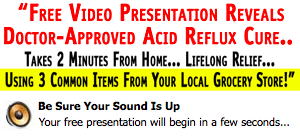October 17, 2011
Hiatal Hernia Natural Treatment
Hiatal hernia occurs when a part of the stomach protrudes through the muscle of the diaphragm into the chest. It appears to be caused by weakened supporting tissue. Hiatal hernia is very common in Western societies, where by the age of 60, over half the population experiences it. It occurs much more seldom in the developing world. Not only increasing age, but also obesity and smoking are risk factors for hiatal hernia in adults. The herniation itself, in most cases, causes no symptoms, but it is associated with gastric acid reflux, which causes several, the most typical of which is heartburn.
It has been proposed that the reason for this discrepancy is that the Western diet is much lower in fiber than that in developing countries. High fiber in the diet makes for a larger, softer stool. The typically harder, drier Western stool requires straining to pass, which increases intraabdominal pressure, pushing the gastresophogeal junction into the thoracic cavity. This is further compounded by the Western habit of sitting with the feet on the floor when passing stool, whereas in the traditional world, this function is performed in squatting position, which does not require straining and thus does not cause the upward pressure.
The problem of hiatal hernia and the associated acid reflux can usually be managed without medication or surgery. Two of the best preventive measures are to lose weight and stop smoking, as both of these worsen the problem. The good news is that doing these two things will also lower the risk of heart disease, cancer, and various other maladies.
The next step is to increase dietary fiber intake. As with the first two preventives, increasing fiber has many additional health benefits, including reducing the risk of colon cancer, varicose veins, and hemorrhoids.
Now we come to a suggestion that many will find more problematic: learning to defecate in a squatting position. This is not easily accomplished using the toilets commonly available in the Western world. It necessitates building up the area surrounding the toilet to create a place on which to place the feet in order to squat. A halfway measure may help: placing a stool in front of the toilet to elevate the feet and leaning forward to defecate.
For those who simply can’t handle the methods suggested to this point, there are still steps that can be taken to avoid acid reflux. You can avoid eating large, heavy meals by eating six smaller meals a day instead of the usual three. You can avoid heavy lifting, which increases the unwanted upward pressure, and can avoid lying down or bending over right after eating. And you can avoid eating for two hours before going to bed and can sleep in a semi-upright position.
Finally, it may help to eliminate certain foods from the diet: alcoholic beverages, coffee, acidic fruit juices, pasta with cheese or sauce, tomatoes, salad dressings, ice cream, fried foods, and chips.
If the hiatal hernia is not causing acid reflux, it is not necessary to do anything, although taking steps to keep it from worsening makes good sense. For more information on Hiatal hernia treatments, be sure to visit Reflux Remedy at refluxremedy.com today!
Filed under Hiatial Hernia by admin
October 10, 2011
Foods That Reduce Acid Reflux
Acid reflux, also known as heartburn, can be painful, troublesome and embarrassing. Some of the symptoms include the distinctive burning sensation in the chest, coughing and belching. You might be treating the problem by chewing antacids by the fistful or taking prescribed medications, which can get expensive. Did you know that you can actually reduce acid reflux with the food you choose?
Acid reflux is caused when the muscle at the top of the stomach doesn’t work properly and stomach acid backs up into the esophagus. The acid then eats away at the lining of the esophagus, causing the burning sensation. Over time, the reflux can cause severe damage to the esophagus and can even lead to esophageal cancer.
While some foods, such as tomatoes, chocolate and caffeinated beverages can make acid reflux and heartburn substantially worse, other foods can actually reduce reflux and help ease the symptoms.
Oatmeal
Oatmeal can help ease the discomfort of acid reflux and makes a great breakfast or even a snack. One of the benefits of oatmeal is that it can actually help absorb the excess acid. Instead of popping an antacid, try eating a bowl of oatmeal instead.
Salad
Salad is good for you on a number of levels, but it’s especially good if you have acid reflux. The fiber in the salad can help your digestive system work better, reducing reflux symptoms. Be sure to avoid tomatoes or onions, and don’t add cheese. A small amount of an acidic dressing is okay, but don’t go overboard. Keep dressing to one tablespoonful or less.
Chicken
To add protein to your diet, chicken is a great choice. You can eat it baked, grilled or broiled, but don’t fry it. You should also remove the skin, as it is high in fat, which can increase acid reflux symptoms. Adding grilled chicken to a salad makes a great dinner for someone who is having trouble with acid reflux.
Fish and other seafood
Fish is another excellent protein to add to your diet to help reduce reflux. Although it can be higher in fat, it’s high in the type of fat your body needs — omega-3 fatty acids. Try to stick with wild-caught, rather than farm raised. Like chicken, broil, grill or bake your fish and don’t add creamy sauces to it. Other seafood, like shrimp, lobster and shellfish are also good.
Parsley
Although parsley makes a lovely garnish, it’s also recognized as an herb that can help with stomach irritation. Add fresh parsley to your soups, salads and other foods and be sure to eat it!
Couscous
Complex carbohydrates are great foods to help with acid reflux. They can help absorb the acid and they are high in fiber. Add these to your meals to prevent post-meal reflux and indigestions.
Ginger
Ginger is one of the all-time best foods to eat to help with indigestion. Although it can also be taken as a capsule, adding it to foods in its whole form is extremely helpful. Seasoning your fish with ginger before grilling it and serving it with a side of couscous or bulgur wheat makes a filling meal that will help ease acid reflux.
For more information on the foods that help to reduce acid reflux, be sure to visit Reflux Remedy at refluxremedy.com today!
Filed under Acid Reflux Treatment by admin
October 5, 2011
Esophageal Reflux Symptoms
Esophageal reflux, also known as GERD, is a common medical condition that affects millions of people worldwide. The symptoms of esophageal reflux vary, but the most common symptoms include heartburn, indigestion, regurgitation, or dysphagia (trouble swallowing). The heartburn is sometimes confused with a heart attack because the pain is located in the epigastic and chest area. However, unlike a heart attack, heartburn feels more like a gradual burn and irritating feeling, while a heart attack is more of a crushing, smothering feeling. The indigestion that comes with esophageal reflux typically comes after a meal, especially a large or heavy one, and leaves an unpleasant feeling inside the esophagus and abdomen. Regurgitation, or the expulsion of food from the mouth, is also common. However, this should not be associated with vomiting. Whereas vomiting is a forceful expulsion of food, the regurgitation from esophageal reflux may be tiny bits of food or hardened bits of white smelly material that can be quickly swallowed back in, leaving a bitter aftertaste. The dysphagia that comes with esophageal reflux is due to stomach acid irritating the esophagus. Sometimes, dysphagia is also a serious sign of complications of esophageal reflux that must be handled immediately.
Other symptoms seen with esophageal reflux include nausea, vomiting, odynophagia (pain with swallowing), and water brash. Water brash is the sour taste in the back of the mouth after a burp or a bout of heartburn that causes increased salivation and acid refluxing into the oropharynx. The sour taste comes from the stomach acid brought upwards. The nausea and vomiting come from irritation of the upper gastrointestinal tract from stomach acid. If the acid reflux is severe enough, it can Some less obvious symptoms tied to esophageal reflux include chronic cough, continual throat clearing, hoarseness, asthma (from acid damaging the lining of the bronchial airways), and erosion of dental enamel. All of these symptoms are secondary to damage from stomach acid. If these symptoms are present, immediate medical attention is warranted.
More serious but rarer symptoms that can be caused by esophageal reflux include cancer-mimicking symptoms such as lack of hunger, wasting away, dysphagia, and dark tarry stools. Usually these symptoms occur after years of untreated esophageal reflux. These symptoms indicate that the esophageal reflux has damaged the upper gastrointestinal tract enough to cause cancer. The continual cycle of stomach acid damaging the esophageal linings and the cells healing themselves can trigger dysplasia in cells later in life and eventually cause cancer.
These symptoms can be treated initially without medical management. Simple lifestyle changes such as sleeping with the upper half of the bed elevated, eating smaller meals, avoiding acidic and heavy foods, and losing weight can provide relief of these symptoms. In addition, cessation of smoking also helps relieve these symptoms. If such lifestyle changes do not help much, medications may be needed to help manage esophageal reflux. Luckily, there are many medications on the market now that can be used to treat esophageal reflux. Some can be obtained over the counter while others require a physician’s prescription. For more information on the causes and cures for esophageal reflux be sure to visit Reflux Remedy at refluxremedy.com today!
Filed under Acid Reflux Symptoms by admin
October 4, 2011
Esophageal Reflux Disease
Over 60 million Americans suffer from esophageal reflux disease according to the American College of Gastroenterology. Sufferers of esophageal reflux disease, also referred to as acid reflux, describe the feeling as an extreme tightness, a burning sensation, or an explosion in the chest. Esophageal reflux disease is a result of a backup of acids from the stomach and the first part of the small intestine (duodenum) into the esophagus, a 25 centimeter long passageway between the throat and the stomach. Because the esophagus is not equipped with the acid-resistant lining of the stomach, massive heartburn is felt upon acid reflux or backflow. The symptoms, causes, and treatment of esophageal reflux disease are detailed.
Symptoms
The physiological symptoms of esophageal reflux disease are described as follows:
- Heartburn that exceeds two days
- Stomachache
- Difficult or painful swallowing
- Persistent coughing, wheezing, or choking
- Hoarseness
- Regurgitation of food or bitter liquid when lying down or bending
Causes/Factor
The main cause of esophageal reflux disease is a weakening of the lower esophageal sphincter (LES), a valve between the esophagus and stomach that opens as food and liquid travel into the stomach. One factor that causes the LES to weaken is the excessive consumption of caffeinated beverages. Other factors linked to esophageal reflux disease include the following:
- Pregnancy, wherein a woman’s body experiences hormonal changes and abdominal pressure
- Obesity
- Lying down after meals
- Alcoholism
- Smoking
For more information on esophageal reflux disease and cures be sure to check out Reflux Remedy at refluxremedy.com today!
Filed under Acid Reflux Symptoms by admin





